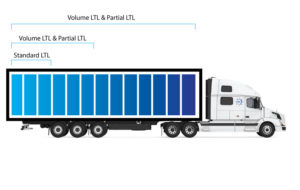What is Volume LTL?
Volume LTL is effectively any shipment that is larger than 5,000 pounds, six pallets or more and is comprised of anywhere between 12 and 32 linear feet of space in a trailer. Sometimes this is called a partial truckload but it does have a very distinct sizing requirement. It also requires the products to be placed on pallets which is not actually one of the requirements for partial TL shipments. this is effectively a way of shipping that leverages an otherwise underutilized trailer space. The volume LTL shipping method is perfectly suited for shipments that might have too many pallets for a standard LTL shipment but not enough for a full truck.

How does Volume LTL works?
Typically, LTL carriers have a specific business model wherein the driver picks up different pallets from a handful of shippers and then drops them off at a regional location to be sorted thereafter. At that point, the carrier sorts through those shipments and consolidates them based on the destination. Then the shipments are transferred from the original Hub to their specific destinations. Once that happens a local driver completes that final leg of the journey and is responsible for a series of multiple stop deliveries throughout their region.
These LTL networks are very big and complex. The carriers are only able to offer competitive pricing based on the dense and complex nature of their network. This means that they work hard to keep every truck as fully loaded as possible whenever it hits the road. But there are many components that play a part in shipping at each stage of the journey and sometimes no matter how efficient the network there will be empty capacity. When this happens volume LTL is used to fill in any gaps and reduce the number of empty miles that a truck drives on the road, and to generate a little bit of extra cash flow in what would otherwise be a cashless segment of the journey.
Pros and cons of Volume LTL
As with any shipping method, there are positives and negatives when utilizing volume LTL. On the pro side, it is cheaper, safer and provides more capacity.
Moving a larger LTL shipment by way of volume LTL is typically going to cost less compared to a full truckload. But why is that? Because efficiency is the backbone of operating an LTL Network. This means that larger shipments can be challenging logistically because it can be a challenge for carriers to foresee how many shipments are coming in and how much trailer space they might actually need for 12 pallets. However, with larger shipments there might be some empty backhauls and carriers will want to have access to those empty backhauls. This is where volume LTL comes into play. In exchange for the type of flexibility that volume LTL offers, you get lower rates.
Volume LTL is also a safer way to ship. Shipments will typically stay on the same trailer from the moment they’re picked up until the moment they’re delivered which means they don’t go through as much handling. They aren’t moved from one trailer to another during transit so the overall likelihood that anything will get damaged is reduced drastically.
Being able to leverage the empty backhauls allows shippers to reach into additional capacity. Right now the LTL markets and the truckload markets are collectively experiencing tight capacity but volume LTL provides a wonderful alternative that can be used to supplement existing networks.
Of course, everything has pros and cons, including volume LTL. Volume LTL can be slower than other shipping options. Precise planning can be a challenge for any company and these shipments typically move at the convenience of the carrier based on the availability of the backhaul. So, if you are trying to ship a product with a strict arrival date this particular option might not be the best suited for you, as it can result in a slower, less definite delivery date.
The lower cargo liability limit for standard LTL shipments means that your liability limit is between $5.00 and $25.00 per pound. However, for a volume LTL shipment that liability drops down to $1.00 per pound so it is certainly not something to use for higher-value products that require a larger liability limit during shipment.
Volume LTL and partial truckload similarities and differences
Although volume LTL and partial truckload methods are often grouped together, they have some important similarities and differences. Key to understanding these is that volume LTL uses an LTL carrier network while partial truckloads use full truckload carrier networks.
Both the volume LTL and partial truckload options are ideal for shipments that are larger than standard LTL sizes but wouldn’t necessarily fill a full truckload. Also, both options are suitable for shippers that want to leverage underutilized space that results in cost savings. Finally, both methods are a form of Specialized Service that handles limited capacity.
Volume LTL benefits for shippers
Shippers that are looking to ship freight via empty backhaul capacity benefit from volume LTL. Volume LTL fills backhaul capacity needs and allows shippers to send cargo with more flexible size requirements and delivery times. More importantly, instead of dealing with multiple LTL carriers, shippers can have their goods sent from point A to point B without having to go through multiple parties. This decreases the possibility of their goods being mishandled or damaged along the way.





2 Comments on “What is Volume LTL and how it Can Improve Your Supply Chain?”
Really appreciate you for this post, keep it up and make posts like these.
Thanks, Mia, we’re glad you enjoyed our content.